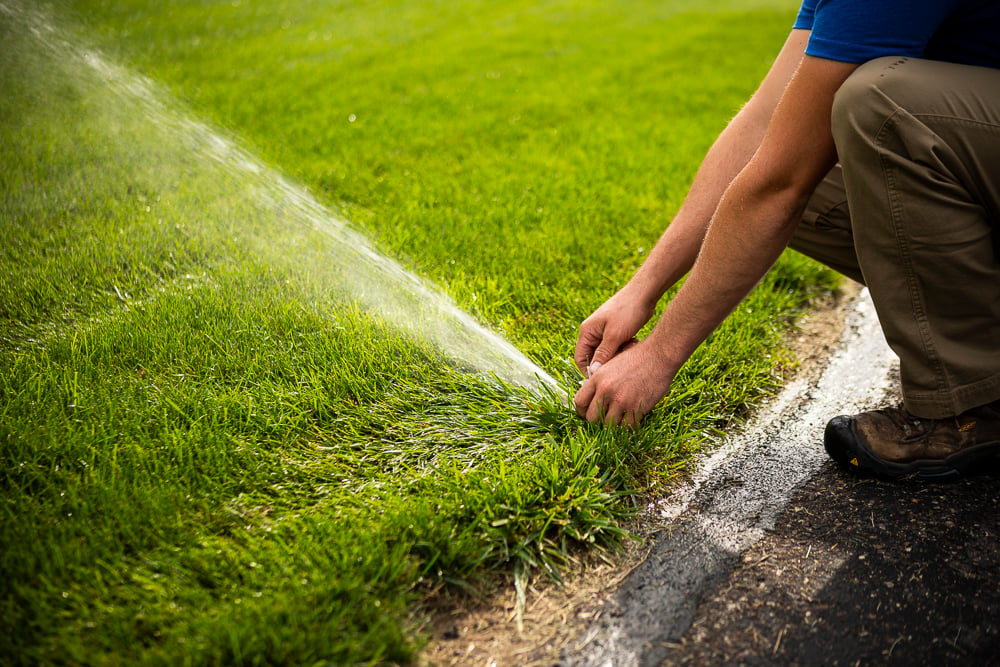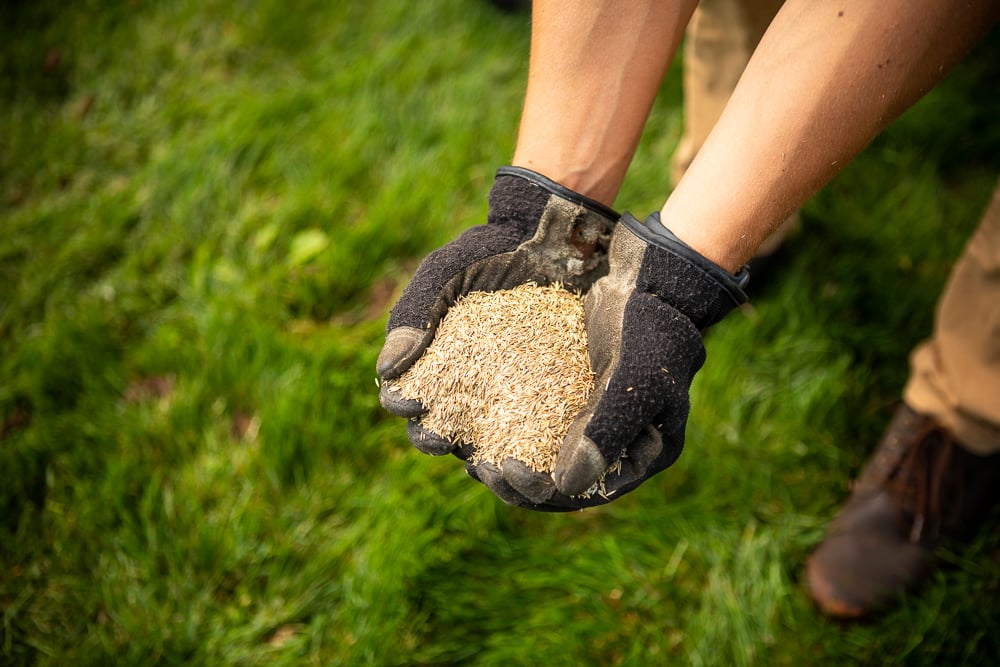The last time it rained so hard there were ducks paddling in your front yard, you probably didn’t feel very lucky.
We are lucky here in Wisconsin and Minnesota, though — nature usually gives us plenty of rain.
But everybody has occasional periods of drought, and it’s easy to panic when your vibrant green lawn turns brown.
How to make a lawn more drought-tolerant? Don’t water it every day, no matter how tempting. Mow tall to keep those important roots shaded. Use granular fertilizer — not liquid.

All these smart lawn care habits encourage a strong, healthy lawn, and healthier, stronger lawns are better able to hang in there when the stress of heat and drought strike.
Keep reading to learn more, including:
- Why you should keep your grass taller
- Keeping mower blades sharp
- Fertilizer facts
- Wise watering habits
- How’s your irrigation system?
- Should you switch to a drought-tolerant grass?
How to Drought Proof Your Lawn? Mow Tall
Keeping your lawn on the tall side is smart throughout the year, but it’s especially helpful in encouraging drought-tolerant grass.
Taller grass shades the soil and those important roots. Keeping the soil shaded means less valuable moisture will evaporate. Your stressed, thirsty grass needs every drop.

Mowing too short actually hurts your grass.
When you mow, you’re removing a portion of the leaf surface that creates food through photosynthesis. Take off too much, and you’re starving your grass.
No more than a third of the grass blade should be removed during a single mowing.
Speaking of Those Mower Blades...
Keep them sharp.
A dull blade “rips” the top off a blade of grass, leaving a jagged edge that invites pests and disease.
A sharp blade makes a nice, clean cut, which helps the grass to heal faster and promotes photosynthesis — which helps it green up again after drought strikes. Healthy grass is drought-tolerant grass.
A tip: don't mow in the heat.
During the heat of the day, when the sun is beating down, is the worst time to mow. Your lawn is stressed. (It’s not great for you, either.)
Wait until evening when it’s cooler. Or hold off an extra day or two if cooler temps are in the forecast.
Drought-Proof Your Lawn with Fertilizer
Fertilizer is a year-round thing. You can’t just panic when drought hits and dump a bunch of fertilizer on your lawn as a pre-emptive strike. In fact, that can do more harm than good. (More on that in a minute.)
Your lawn is hungry year round, and if you keep it fed throughout the year, it will be stronger, healthier and better able to get through drought.
Granular fertilizer is best.

Granular fertilizer is solid pellets of product spread over your lawn then watered into the soil.
The basic nutrients in liquid lawn fertilizer are the same as in granular fertilizer, but they work a bit differently.
Liquid fertilizer delivers a quick dose of nutrients, while granular fertilizer offers a slow steady release of food for your lawn over time.
You especially want to avoid liquid fertilizer during drought. It will stress a lawn suffering from drought because it’s designed to work fast, putting more stress on your weakened lawn.
Water Your Lawn Wisely
How to drought-proof your lawn? Don’t water it every day.
This is a tough one, right? You want to set up a cot out there and hold the hose on your precious lawn 24/7.
But watering every day, even when it’s like the Sahara out there, actually weakens your lawn.
Water your lawn deeper, longer, and not as often. That encourages deeper, stronger roots.

If you water too often, it encourages roots to hang out near the surface. Why should they head deeper in the soil to search for water when you’re serving it up so readily every day?
Deep, strong roots mean a more drought-tolerant lawn.
When drought does strike, take a look at your irrigation controller. Maybe you haven’t adjusted it since spring and it’s not set to water long and often enough to make up for the lack of rain.
Increase the duration and frequency of watering to get your lawn through the drought.
Also, water early in the morning, before the heat of the day. Why let the hot sun evaporate all that precious water?
How’s Your Irrigation System?
Don’t just say, “Fine, thanks.” Really have it checked.
How to keep your lawn alive in a drought? For starters, don’t let your irrigation system break down.

Have it inspected — not just to make sure each important component is working as it should, but to ensure you’re not wasting any valuable water.
Irrigation specialists will give it a thorough check, inspecting everything from sprinkler heads to zones to your controller to make sure everything’s working perfectly and ready to work hard during those extra dry spells.
And if they spot any water waste, they’ll let you know exactly how to stop it.
Are There Drought-Resistant Varieties of Grass?
Sure, most every type of grass has a variety designed to withstand drought better than others.
Should you switch to a drought-tolerant grass?
No need around here.
Homeowners here in Minneapolis and Eau Claire don’t typically choose their grass seed based on the best grass for drought. They’re more interested in a lawn that’s soft and has a dark green color. Maybe they struggle with a shady yard and choose grass seed designed for that.
While every turf type has a variety that’s more drought tolerant than others, chances are, the grass you already have will hang tough, as long as you’re giving it the proper care all year to keep it strong and healthy.
Your lawn is probably a mixture of three types of grass: bluegrass, fescue, and rye.

Blends like this are great. Every type of grass has advantages and disadvantages, and with a blend, you get a bit of all their good qualities.
Fescue does better in shade. Rye stands up well to high foot traffic. Kentucky bluegrass, which everybody loves for its impressive green color, thrives in the sun and has good drought tolerance.
Treat it well, and it will bounce back from drought damage.
How to Drought-Proof Your Lawn? Bonus Tips
Add potassium. Potassium, an important nutrient for grass, can help it tolerate drought stress by increasing its water efficiency.
Avoid adding nitrogen to your lawn during drought. Like that liquid fertilizer we mentioned earlier, nitrogen encourages grass to grow. When it’s stressed by drought, you just want it to survive. Give it a chance to rest up.
If your grass is brown during hot, dry weather, don't worry - that's normal dormancy. You lawn isn't dead.
When drought strikes, even healthy grass turns brown and goes dormant. It’s a way of protecting itself through the stress.
If it went into dormancy healthy, it’ll bounce back and green up when the drought stress is over.
Encourage a Drought-Resistant Lawn with RainMaster
If trying to tackle all these drought-proofing tips makes you and your lawn thirsty, turn it over to the pros. Get on board with comprehensive lawn care services in Minneapolis, MN & Eau Claire, WI designed to produce the strongest, healthiest grass.

You choose from three different levels of lawn care programs at RainMaster, based on the results you’d like, how fast you want to see results, and your budget.
Ready for a strong, healthy and drought-proof lawn? Request a quote today! We’ll review your lawn care options together so you can make a great choice. Then, you can stop worrying about your lawn and find time to relax.




